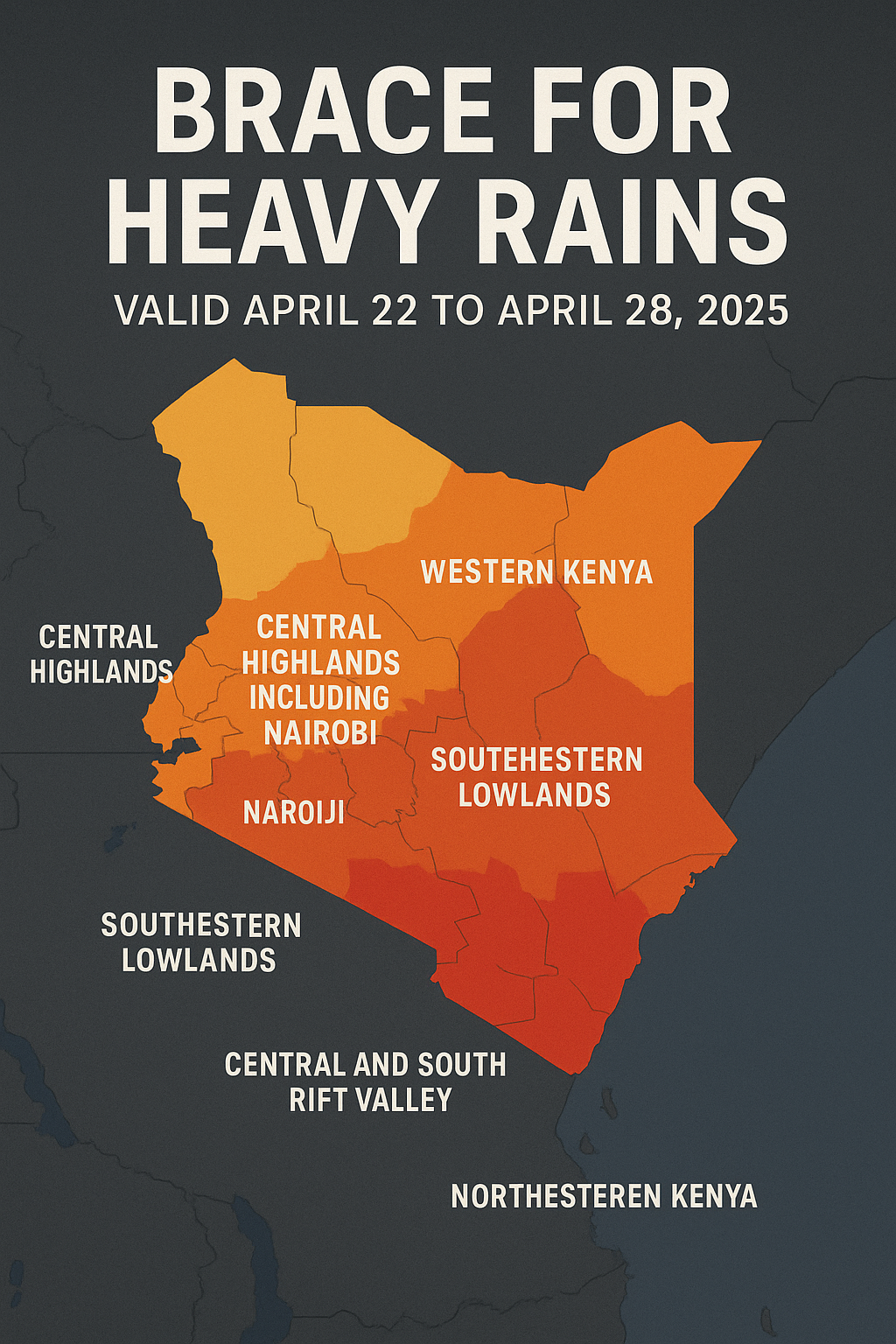
simply amazing, always for you.
By Getuma Okemwa, April 23, 2025

Kenyans have been urged to prepare for a surge in intense rainfall over the next seven days as weather authorities issue warnings of potential flooding across multiple regions. In its latest public advisory, the Kenya Meteorological Department (KMD) projects heavy rainfall to persist from Tuesday, April 22 through Monday, April 28, 2025.
David Gikungu, the Director of KMD, said in a Monday evening notice that the rains will primarily affect the Central Highlands (including Nairobi), Western Kenya, the Lake Victoria Basin, the Southeastern Lowlands, the Central and South Rift Valley, and Northeastern Kenya.
“Residents in the affected areas should remain alert to potential flooding and weather-related disruptions,” Gikungu emphasized.
Disruptions Already Underway in Nairobi
Even before the rain hits its peak, Nairobi’s residents are already grappling with its impact. Roads in several estates, including South B, Embakasi, and Zimmerman, have become flooded and nearly impassable. In some areas, floodwaters are rising above sidewalks, posing serious risks to vehicles, pedestrians, and low-lying homes.
On Monday, Mark Kirui, a 43-year-old resident of Embakasi, found himself stuck when his car stalled while navigating a flooded stretch of road.
“I misjudged how deep the water was. By the time I realized, the car had stalled and water was seeping in,” he said.
Commuter Train Services Affected
In another incident linked to the heavy rainfall, more than 130 passengers were stranded at Nairobi’s Central Railway Station on Monday evening. Floodwaters along the railway line disrupted operations to the Syokimau Standard Gauge Railway (SGR) station.
According to affected passengers, the station’s management arranged for alternative transportation, but by 9:15 PM, many commuters were still awaiting buses, with little clarity or communication about the delay.
Low-Income Settlements Face Heightened Risk
For residents in informal settlements such as Kibera, Mathare, and Mukuru, the rains represent more than just an inconvenience—they’re a direct threat to life and property. Without proper drainage and infrastructure, these communities are highly vulnerable to flash floods and waterborne diseases.
Local emergency response teams are on standby, but access remains a challenge in flood-prone slums where narrow paths and poor planning hamper swift evacuations.

ICPAC Confirms Wet Outlook for Eastern Africa
The IGAD Climate Prediction and Applications Center (ICPAC), the regional climate monitoring body, has echoed KMD’s warnings, forecasting above-average rainfall for eastern Kenya and large swathes of East Africa during the same week.
In its weekly weather outlook, ICPAC predicts:
- Moderate rainfall (50–200mm) in Rwanda, Burundi, northwestern and southern Tanzania, western Uganda, coastal, northeastern and western Kenya, western Ethiopia, northern South Sudan, and southern Sudan.
- Light rainfall (under 50mm) in southern South Sudan, southern Sudan, southern and western Ethiopia, central to southern Somalia, and central Kenya.
ICPAC cautioned that the expected heavy rains in northeastern Kenya and parts of Tanzania could trigger localized flooding, especially in low-lying and poorly drained areas.
“Communities in flood-prone zones should remain vigilant and avoid flood plains and riverbanks,” ICPAC advised.
Warmer-Than-Average Temperatures Forecast
Compounding the challenge, temperatures across the region are also expected to trend higher than normal. The hottest areas, including parts of Sudan and Ethiopia’s Afar region, are forecast to experience highs above 32°C.
Meanwhile, most other parts of East Africa—including Kenya, Tanzania, Somalia, Uganda, and Ethiopia—will see moderate to high temperatures ranging between 20°C and 32°C, contributing to a humid and uncomfortable environment, particularly in urban areas like Nairobi and Kisumu.
Precautions and Preparedness
Both KMD and ICPAC are urging citizens to take proactive measures:
- Avoid walking or driving through floodwaters.
- Stay tuned to official weather alerts and advisories.
- Secure emergency supplies, especially in areas prone to flooding.
- Keep drainage around homes clear to minimize waterlogging.
- Report blocked stormwater drains or downed power lines to local authorities.
Looking Ahead
As the rains intensify, many parts of Kenya may experience transport delays, power outages, and increased risk of disease outbreaks. The next seven days will test the resilience of urban infrastructure, emergency response mechanisms, and community preparedness.
For those in vulnerable areas, this week is not just about umbrellas and raincoats—it’s about making life-saving decisions and staying informed.
Stay safe. Stay dry. And don’t underestimate the power of the storm.
